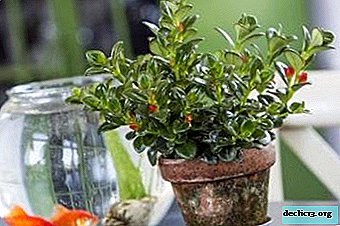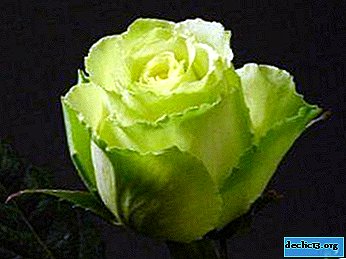Features of radish pest control. What methods will help get rid of them?

Most gardeners grow radishes in their gardens. This precocious crop is practically not susceptible to disease, but still has no absolute protection and needs high-quality care.
That is why it is important to know the main symptoms of plant damage by insects and be able to identify the problem at an early stage when the crop can be saved without much effort.
The danger of harmful insects for radishes
Pests that attacked young plants can destroy crops completely in just 3-5 days. This is extremely dangerous for young, only emerging plants - for example, damage to leaves and stems of radishes completely stops the growth of the root crop and, as a result, the plant quickly dies.
How to determine what exactly struck a plant: a disease or parasites?
If the disease struck the radish - it will be possible to determine this by characteristic signs - any failure will quickly affect the physiological state of the plant.
Symptoms of fungal infections and viruses are:
- A whitish, oily coating that appears on the surface of plants.
- Growths on root crops, eventually acquiring a brown color.
- Black, yellowish or rusty spots on the foliage of plants.
- Brown spots and mold on root crops.
- Yellowing of foliage and its subsequent death.
If the landing is attacked by pests, the lesions will be primarily of mechanical origin. Ulcers, holes in foliage, holes in root crops, etc. are clear signs of insects.
Photos of harmful insects and methods of combating them
Next, you can see how the most dangerous radish pests look in the photo and find out how to get rid of them.
Cruciferous flea

Small flying insects with an oval body, the size of which does not exceed 4 millimeters.
The danger for radishes is most often represented by black fleas that can move on the ground with frequent jumps. The pest relates to leaf beetles. Getting on a plant, it affects the leaves of a vegetable crop, biting into the foliage and quickly destroying it. With a critical defeat, the radish freezes in development and dies.
The pest is most active on warm, dry days, when the air temperature exceeds 25 degrees.Consider how to process radish crops and soil to get rid of fleas and whether folk remedies will help.
You can protect the bed with a mixture of ash and tobacco dust. The composition should be scattered on the bed, re-treatment is recommended after 6-8 days.
If there are too many fleas, you can deal with them with specialized drugs such as:
- Alfacin.
- Kaiser et al.
To prepare the solution, it is necessary to mix the preparation according to the instructions with warm clean water and process the planting.
Processing should be carried out in dry weather in the morning or evening.
Most drugs last for 2-3 weeks, and the insects remaining in the garden die on the 4th-6th day after processing the crops.
Belianka

This pest is a white butterfly that lays its larvae in the topsoil. The danger to the radish is the caterpillars hatched from them, which quickly move to the leaves of plants and eat them.
A mixture of 2 tablespoons of mustard, a teaspoon of ground black pepper, 2 tablespoons of salt dissolved in 10 liters of water will help get rid of pests. To process the bed should be once a week using a spray gun.
The chemical industry also effectively fights against whitewash:
- Spark.
- Kemifos.
- Fitoverm et al.
Cabbage Moth

Cabbage moth is a butterfly 2 cm in length with gray-brown wings. The larvae of this insect live on the back of radish leaves, eating them.
You can prevent the appearance of insects in a timely manner fertilizing the soil with superphosphates containing calcium chloride.In the case of a massive damage to the crops, the bed can be treated with the following drugs:
- Lepidocide.
- Bitoxibacillin.
It is allowed to carry out processing strictly until the fruit ripens.
The preparation prepared according to the instructions must be sprayed over the affected plants. in calm, dry weather. The temperature should not exceed 35 degrees heat.
Cabbage fly

One of the most common pests of radishes and other cruciferous plants. This fly of light ash color has a characteristic strip on the abdomen and three dark stripes on the back. Its size rarely exceeds 6.5 mm.
A danger to radishes is represented by insect larvae that feed on the soft core of the stems and move deep into the plant along them. Caterpillars are able to completely destroy the plant.You can protect the landing by applying any means based on naphthalene, lime or camphor oil. With solutions of these substances, the bed should be treated at least 2 times a week.
If pests have affected more than 20% of the garden, the use of chemicals is recommended. Effectively fight the larvae of the cabbage fly:
- 50% malathion. 60 gr the drug should be diluted in 10 liters of water and sprayed with plants.
- Topaz. Processing seedlings is carried out with a solution prepared from 1 ampoule of the drug and 10 liters of water.
- Zemlin. The tool is intended for tillage immediately before planting. It should be applied to the soil at the rate of 3-5 gr. per square meter immediately before transplanting seedlings. The death of the larvae occurs in 20-24 hours.
Garden scoop

It is a butterfly of sand color, the larvae of which are able to completely destroy the shoots of radish. Such a defeat is fraught with the fact that the greenery of the plant will develop, but the root crop will not be able to gain weight.
- A mixture of dry minced tops (0.5 kg), 50 gr. Is effectively fighting the pest. alkaline soap and 10 liters of pure water. After the ingredients are mixed, the container should be placed in a warm place for 4-5 hours. It is recommended to cultivate crops in dry, calm weather.
- Of the chemicals, Zeta-cypermethrin and Inta-Vir are effectively combated. To prepare the Inta-Vir solution, you need to dilute 1 tablet of the drug in 7-10 liters of water and spray the crops once.
Cabbage butterfly

Butterfly with white or yellow wings, insect caterpillars feed on the leaves of the plant.
The mechanical method is most effective in controlling these pests. - manual collection of insects with subsequent processing of plants with coniferous solution.
You can prepare the solution on your own (pour 200 g of cones with 2 liters of boiling water), or purchase ready-made coniferous extract in pharmacies.
In pest control, such remedies are also effective:
- Lepidocide;
- Spark M;
- Fitoverm.
Wireworm

Wireworm - the larvae of the nutcracker beetle, which are small brown worms up to 2 cm long. They feed on root crops, gnawing passages in the pulp of radish. The affected fruit rots from the inside.
- At the first symptoms, indicating the appearance of wireworms, it is recommended to treat the soil with fertilizers containing ammonium sulfate.
- With a massive lesion It is recommended to use Bazudin, which is applied to the soil at the rate of 1g. 1 meter square.
Stem nematode

Small, whitish worms, the size of which does not exceed 2 mm. They feed on radish juice, living in the root neck of the plant. The affected root crop quickly begins to turn yellow and fade.
An effective way to control insects is to treat crops with infusion of marigolds. To prepare it, 500 grams of crushed dried flowers are poured with a bucket of boiling water, 50 grams of soap are added and insisted for 5 hours.
Spray the bed at least 1 time per week.
Industrial drugs effective against nematodes:
- Rogor-S.
- Vydate 24L.
Rapeseed sawfly

The beetle, reaching 8 mm in length, has a bright yellow color with 2 black marks on the back. Wings are yellow at the base with a black border around the edges. Adult insects are not dangerous for radishes, but hatched caterpillars feed on plant leaves, gnawing numerous holes in the ground part of the culture, which quickly leads to death of the plant.
When dealing with a rapeseed sawfly, an infusion of black bleached is effective. For its preparation:
- 600 grams of dry leaves should be poured with 2 liters of boiling water and left in a dark place for 12 hours.
- After add 50 gr. alkaline soap and diluting the infusion with 8 liters of cold water to spray the affected bed.
Chemicals effective in controlling the sawfly:
- Denrobacillin.
- Entobacterin.
A solution of Entobacterin is prepared at the rate of 10 gr. per 1 liter of water.
Crucifer bug

Small black beetle, the size of which does not exceed 4 mm with bright stripes on the wings of orange. It feeds on radish juice, which quickly drains the young leaves of the plant.
Datura infusion can protect the plantings, which is prepared at the rate of 0.5 kg of dry leaves per 10 liters of hot water. After mixing, the container should be left for 12 hours to infuse, and then treat the affected plants.
Repeat the treatment must be no later than 5 days.
Fosbetsid and Actellik also effectively control pests. Use drugs in accordance with the attached instructions.Summer cabbage fly

The danger to the radish is the insect larvae - worms up to 8 mm in size whitish. They feed on the soft core of plant stems, gradually moving towards the root crop.
Strong saline solution - 200 gr. salt dissolved in 10 liters of water. They should water the plants, and then sprinkle ash on the affected area.
Insecticides that effectively fight cabbage flies:
- Karbofos.
- Alatar.
- Topaz.
- Fufanon Nova.
- Rowikurt.
- Zemlin.
Prevention
Since pests are primarily attracted by young, weakened shoots, timely feeding of radishes becomes an effective measure to prevent their appearance.
To prevent the appearance of insects, you can also:
- To process crops with ash and slaked lime.
- Spray the beds with infusion of wormwood.
- Treat the emerged seedlings with a solution of vinegar (1 cup per 10 liters of water).
At the end of the season, crop residues must be carefully removed from the site, since it is in them that pests can settle for the winter.
Timely prevention and careful monitoring of crops will help the owners of household plots to effectively deal with pests that threaten radishes, and get a rich harvest is a popular crop.

















